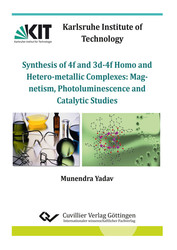| Areas | |
|---|---|
| Serie de libros (96) |
1379
|
| Nachhaltigkeit |
3
|
| Gesundheitswesen |
1
|
| Letra |
2367
|
| Ciencias Naturales |
5407
|
| Matemática | 229 |
| Informática | 319 |
| Física | 980 |
| Química | 1364 |
| Geociencias | 131 |
| Medicina humana | 243 |
| Estomatología | 10 |
| Veterinaria | 108 |
| Farmacia | 147 |
| Biología | 835 |
| Bioquímica, biología molecular, tecnología genética | 121 |
| Biofísica | 25 |
| Nutrición | 45 |
| Agricultura | 1004 |
| Silvicultura | 201 |
| Horticultura | 20 |
| Ecología y conservación de la tierra | 148 |
| Ciencias Ingeniería |
1793
|
| General |
98
|
|
Leitlinien Unfallchirurgie
5. Auflage bestellen |
|
Erweiterte Suche
Synthesis of 4f and 3d-4f Homo and Heterometallic Complexes: (Tienda española)
Magnetism, Photoluminescence and Catalytic Studies
Munendra Yadav (Autor)Previo
Indice, PDF (120 KB)
Lectura de prueba, PDF (420 KB)
The term “lanthanide” was introduced by Victor Goldschmidt with the name of its first element “lanthanum”.1It has the outer electronic configuration 6s25d14f0, so it can either be considered as a d-block elements or an f-block element. The relative energy of the 5d and 4f orbitals are very similar and sensitive to occupancy of orbitals but on the basis of stability of 4f shell which is slightly more compare to 5d shell, it was considered as f-block element. This criterion was followed by next 14 elements and electrons enter in the 4f shell until at lutetium.2The lanthanides are 15 elements in the periodic table considered as the first f-block elements, starting from lanthanum (59La) to lutetium (71Lu), which are commonly referred as “rare earth metals” along with scandium and yttrium. They are chemically represented by the symbol “Ln”.
| ISBN-13 (Impresion) | 9783954049615 |
| ISBN-13 (E-Book) | 9783736949614 |
| Formato | A5 |
| Idioma | Inglés |
| Numero de paginas | 152 |
| Laminacion de la cubierta | mate |
| Edicion | 1. Aufl. |
| Lugar de publicacion | Göttingen |
| Lugar de la disertacion | Karlsruhe |
| Fecha de publicacion | 27.03.2015 |
| Clasificacion simple | Tesis doctoral |
| Area |
Química inorgánica
|








